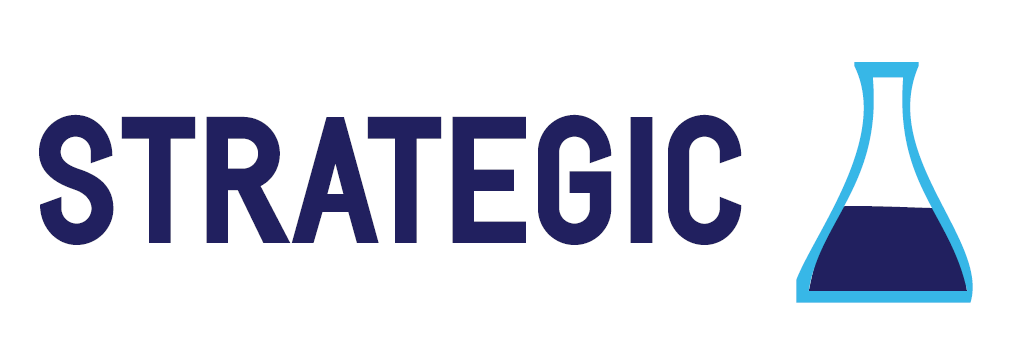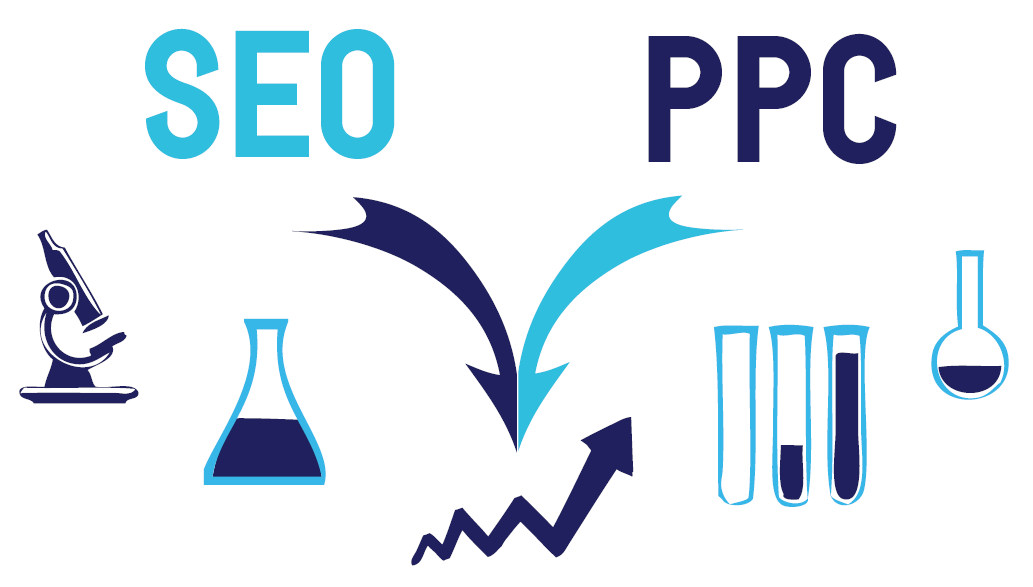 What is the first thing you do when starting an SEO campaign? Many people are so eager to get started on a brand new website or client, they overlook the wealth of data available to you in AdWords.
What is the first thing you do when starting an SEO campaign? Many people are so eager to get started on a brand new website or client, they overlook the wealth of data available to you in AdWords.
From optimising your pages to rank for high converting long-tail keywords, to reducing overall PPC spend by ranking organically, there are many angles which you can take. Here are some actionable ways that you can use PPC data to the best effect on your SEO campaign.
Ultimately, the first step in any online marketing should be determining goals, objectives and KPIs.
From this, you can use the PPC data in order to deliver on these goals and objectives. Too often, an SEO campaign is built on ‘increasing authority’. Ultimately this is what we are trying to achieve, but by being more targeted in your approach, we can prioritise where the biggest opportunity exists.
Here is how I would start using PPC data to build a keyword portfolio.
Conversion keywords
Starting with the conversion rate, you are likely to find longer tail keywords which usually means less competition. Make sure that clicks are above 50 in order to get a more accurate representation of how the keyword converts. It’s also a good idea to keep your eye on impressions and CTR, as this data can be utilised in marginal gains.
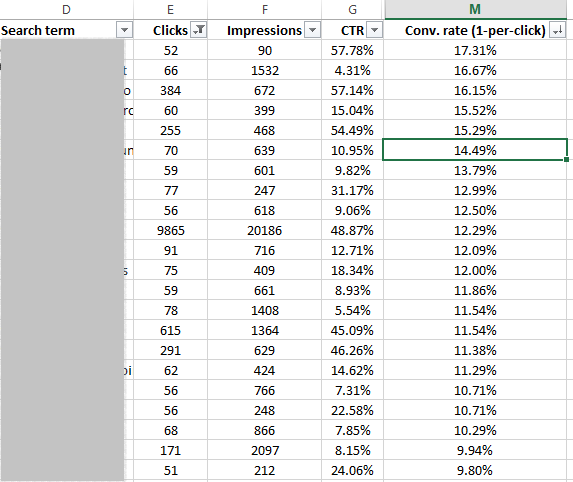
From this, pull the top 25 keywords and place them into a separate document. You may want to use branded results in this (making sure the correct landing page is ranking for all branded terms is paramount), or alternatively you can strip these out for a completely non-brand strategy.
Revenue keywords
Next, order by total revenue, and pull an additional 25 keywords from this list. This is obvious – the keywords that are driving most revenue are often the most valuable to your or your client as a business.
These are no doubt very broad, and it is likely to take longer to rank organically for these terms. However, if they are performing well from a paid perspective, they are likely to be extremely relevant for your business and should be a longer term goal.
High value
Finally, order the keywords by cost per click. Check these are relevant to the client (if they are paying for these keywords, they are likely to be). These are the keywords which cost the client the most – if we can increase our organic ranking this can actually make the clients business more profitable – a great case study to show the value of SEO.
Now, you have the basis for a strategic SEO Campaign! You have a three pronged approach – Revenue Drivers, High Converters and High Value keyword groups.
At this point, I would consider undertaking detailed keyword research to build out the revenue drivers and high cost per click keywords. This will give us greater scope as to where the opportunities are – as it may be the client isn’t using PPC for a certain area of the site. A comprehensive guide to keyword research can be found here.
Also, an interesting technique to build out longer tail keywords in to use a variety of tools to find less competitive keywords that have search volume behind them.
If possible, if you are not currently bidding on these keywords, it would make sense to test them using PPC in order to see if the opportunity exists.
By tying the two together, we can really get some actionable data which can define future strategies. A great tool to build out these longer tail keywords is Long Tail Generator.
Google Webmaster Tools data
Once you have your full list of keywords, we can start to delve into the data. By downloading the last month’s data from Webmaster Tools, we can quickly see where we are currently ranking for these keywords:
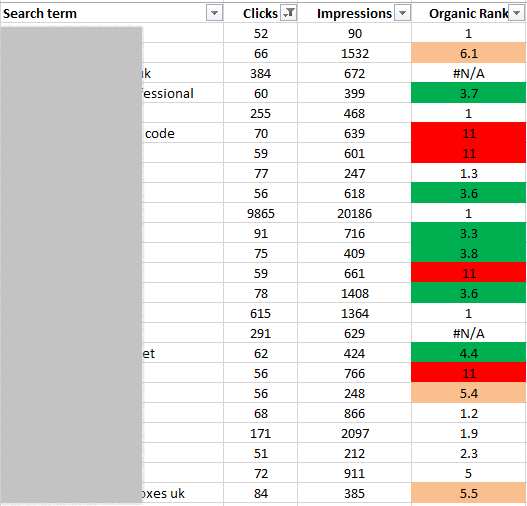
You can easily use a VLOOKUP to do this (if you’re not using VLOOKUP yet – start! It will speed excel work up so much) for more information, see this post by Ross.
I have colour coded these positions. Red is a priority as we currently are not ranking on the first page, orange highlights keywords out of the top 5 and green are keywords out of the top three.
This instantly gives us direction as to where to look first. What is holding us back from these key positions? It’s our job to find out.
Quality score
Quality score is something that a lot of people forget about. Google are likely to use a similar algorithm in order to determine if your landing page is relevant for a keyword organically as they do paid. Obviously certain aspects of the algorithm will be different, but fundamentally the CTR and landing page score must play a factor.
Think like Google – what do they want to show? The most relevant result! This score effectively tells us if our landing page is relevant for this keyword – if the score is low, your recommendations should reflect this, as it may mean there should be more copy on the page, the <h1> tags should be more reflective of intent or you simply need to create a new landing page that is more relevant.
Quality score must be based on usability in some way – by offering users a good experience, you are a relevant result.
To find out more about quality score check out these articles by Search Engine Land and Search Engine Watch.
Now you have all of your keywords, it may seem like there is almost too much data to work with. You will have a good idea of what you should be targeting due to revenue figures, however there is only so much time in a day, so we can’t do it all at once!
Here at Search Laboratory, we use a great platform BrightEdge to monitor all organic activity – within this tool, we have Opportunity forecasting. This allows us to look at a group of keywords (in this case we used the High Converting keywords). This allows us to see what effect this would have to the bottom line by increasing positions for these keywords at either a conservative, moderate or aggressive SEO strategy.
 We can look at the conversion rate, conversion value and search volume increase in order to estimate what effect this will have on the bottom line.
We can look at the conversion rate, conversion value and search volume increase in order to estimate what effect this will have on the bottom line.
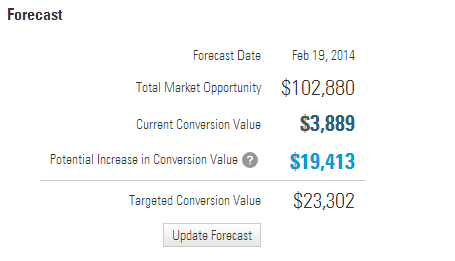
We can then look at current conversion value, as well as potential increase in conversion value and the whole market opportunity. By running our three keyword categories through this tool, we can get direction on where we should put the majority of our resource in order to deliver fantastic results and a return on investment.
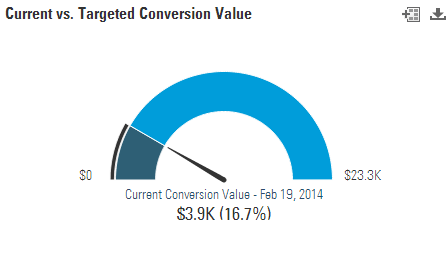 PPC spend reduction
PPC spend reduction
A lot of digital marketers see investing in SEO as a way to reducing PPC cost over time. There are many schools of thought, and studies undertaken to analyse this (see my own in the section below). If that is an objective you have been tasked with, then it is obviously essential to base your SEO strategy on PPC data.
The high value keywords which we highlighted earlier come into their own here. By targeting these keywords, we can reduce spend over time and see the effect this has on the bottom line of your client.
By looking at the average amount of clicks from PPC, and multiplying by average cost, we can work out a figure of how much spend could be reduced by ranking in a top position. Cannibalisation is covered below.
This is a great metric to take back to your CMO or your client:
By working with us, you saved £xxx on PPC spend.
There are many factors at play here, some covered by Search Engine Land and Bright Oak.
A general idea is that bidding on terms you rank well for can have different affects depending on the competitive landscape.
If no one is bidding on a keyword and you’re ranking #1 for it organically, then there will be some cannibalisation if you decide to bid on it (i.e. There is a good chance that 1+1= 1.5).
If everyone is bidding on a keyword (all 10 positions) and you’re ranking #1 for it organically, then if you advertise, you’ll cannibalise your competitors more than yourself (so 1 + 1 = 2, or even 2.4 maybe).
If only a few competitors are bidding on a keyword and you’re ranking #1 for it organically, that’s a tough judgement call.
If the CPC is high, competitors are bidding aggressively on this, therefore it may not be wise to completely remove spend. The bottom line is, if you don’t cannibalise yourself, someone else will do it for you.
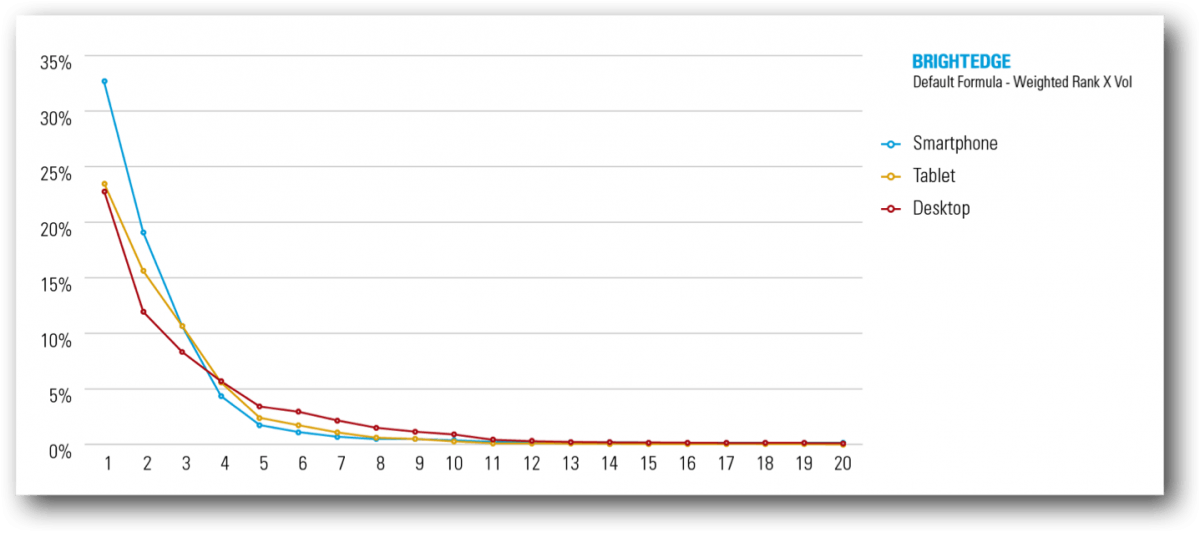
Source: https://www.brightedge.com/seo-platform
A final thought…
Marketing is an art – no doubt about it. Yet, with a wealth of data that we can gain from various data sources, we need to be putting this to better use. PPC data should be something that we are consistently using in our SEO strategy – without it, we are ignoring a huge data source which could give you the competitive advantage.
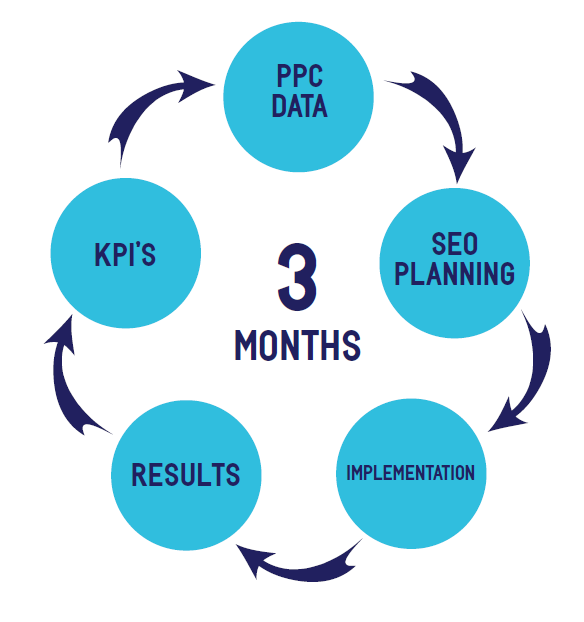
Build PPC data into your 3 month SEO plan, make it as measurable as possible and see the rewards!
